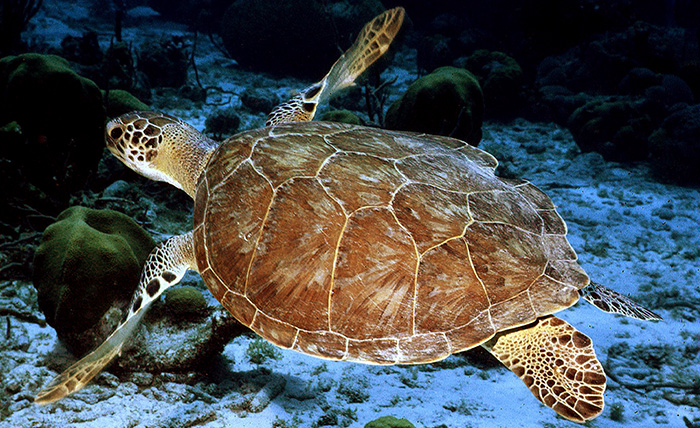 |
| Green turtle, Chelonia mydas. Image courtesy of NOAA. |
The researchers performed separate experiments (both in Mexico) in order to test their two hypotheses. The first experiment, conducted in a turtle-rich area known as Punta Abreojos, sought to determine whether the UV LEDs really did reduce sea turtle capture rates. Pairs of nets--one fitted with active LEDs and the other fitted with bulbs that weren't turned on--were deployed between sunset and sunrise. The researchers checked the nets every 90 minutes in order to retrieve, measure, and tag any turtles that had become ensnared. The second experiment, conducted in a commercial fishery in Bahia de los Angeles, was designed to investigate whether the LED devices affected fish capture. This part of the study used a paired-net design similar to that described above, only the nets were about four times as large and were left undisturbed all night. The next morning, all captured fish were retrieved and categorized as target species, bycatch, or "other" (e.g., kept by the fishermen as food or bait).
 |
| How a gillnet works. Image courtesy of the AFMA. |
Of 332 green turtles captured during the first part of the study, only 123 (37%) were from UV-illuminated nets; the remaining 209 were captured from the nets without diodes. Although 123 is a sizeable number, the difference between lit and unlit nets was significant, indicating that use of these BRTs could substantially reduce turtle bycatch rates. Results from the second part of the study were similarly encouraging. Unlit nets only caught 46 more target fish than those fitted with UV lights (355 vs. 309); likewise, both types of net yielded catches with comparable average market values ($15.10 vs. $15.00).
These findings appear to be an excellent first step in the development and eventual distribution of a new turtle-deterring device. The UV LEDs may be improved by further behavioral studies exploring just how they work. In particular, it would be interesting to know whether turtles are avoiding the LEDs themselves, or whether the UV rays help the turtles see the fishing nets better. It will also be necessary to perform additional work that combines the two parts of this study into a single experiment; by choosing a field site that is both a commercial fishery and an area of high turtle density, scientists can investigate whether these BRTs are a practical solution to the problem of turtle bycatch.
 |
| Light-emitting diodes, or LEDs. Image courtesy of Instructables. |
---
You can also follow Anthrophysis on Facebook and Twitter.
Wang, J., Barkan, J., Fisler, S., Godinez-Reyes, C., and Swimmer, Y. 2013. Developing ultraviolet illumination of gillnets as a method to reduce sea turtle bycatch. Biology Letters 9(5), online advance publication.
No comments:
Post a Comment